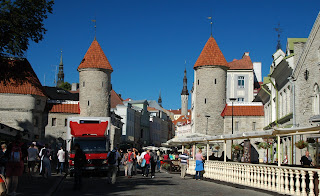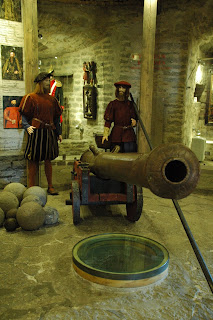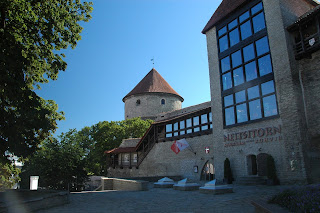We took the bus in to Habujaama, from which it was but a short walk to Vīru värav (Vīru Gate), one of the entrances through the old city walls. Outside the gate in the street Vīru are flower stalls all the way in.
We got just inside the gates and found a McDonald's, ideal for a caffeine fix and to sit and plan our movements — we already had a reasonable map. We went up to the Town Hall Square, to the information office, to pick up whatever guides and any better maps they had, then wandered down Vene and Katarina Kaik (St Catherine's Passage), where there is a permanent display set up of 14th century tombstones from St Catherine's Monastery. Katarina Kaik is the home of the St Catherine's Guild, and the master craftsmen have their open workshops in small 15th to 17th century rooms on the south side of the passage.
Round the corner into Müürivahe, we found the Dominican Monastery Claustrum, the remaining rooms of St Catherine's Monastery, established in 1246.
Just up Müürivahe we found Hellemanni torn (Hellemann Tower), one of the towers in the old city wall, now containing a small art gallery, but also providing access to a walk along a 200m stretch of the city wall, from which we could see across the rooftops, up to St Olaf's Cathedral.
Coming down from the city wall walk, we walked up to St Nicholas Orthodox Church, not that old — it was built in the 1820s — but a striking place in its own right. The interior, filled with magnificent icons, is stunning, but a no-camera policy means we can't show it to you.
From here, we went through some back streets until we came to St Olaf's Cathedral. This 14th century Gothic church could possibly be the pride of Tallinn. Its 159-metre medieval spire meant that it was considered the tallest building in the medieval world. Warren wasn't so sure of this, as the towers of Cologne Cathedral, which dates back this far, are considerably higher — but they weren't added until the 19th century! But the spire was its downfall, in a way — it was struck repeatedly by lightning and burned. The current spire is only 124 metres, but is still impressive.
From St Olafs we took our time to walk the length of Lai, at the end coming to a virtual cliff-face, with buildings on the top, and a waterfall that ran down the hill and into a lovely garden with a beguiling statue of a deer.
We went up towards the lower end of Pikk where we found the Great Guild Hall, containing the Estonian History Museum. The building itself is a magnificent relic of Tallinn's past, and the displays inside gave a far better context to what we were exploring. Inside, for example, was a display of the history of Estonia's Coat of Arms. The current Coat of Arms, with three blue leopards — yes, leopards, even though they are obviously lions, because, in heraldry, the fact that they are pictured full face means they are termed leopards! — on a gold shield garlanded with oak leaves. Also in the museum os a fascinating numismatic collection, covering all coinages used in what is now Estonia, back to very early periods. There is one coin on display which must be one of the rarest known — there are apparently only eight known to exist. The heavy srebeniks issued by 'Yaroslav the Wise' of Kiev sometime between 1014 and 1040, were approximately 3 grams of silver, minted probably in Novgorod, and carried Saint George on the obverse (George = Yuri, and was Yaroslav's patron saint) and a trident on the reverse, the symbol of Yaroslav's Rurik Dynasty. The coin is in amazing condition!
Opposite the museum is the Holy Spirit Church. On its outer facade, facing the museum, is an elaborate painted clock, Tallinn's oldest public timepiece.
We went back into the Town Hall Square and the Town Hall, which by now was a hive of activity. Gisela had warned us that tourists descend on Tallinn in the Summer — it's been going on for at least 200 years, as the Russian nobility used to use Tallinn for a summer getaway. But that brings a lot of much-needed capital into the economy! There are various means of transport to get the tourists around — there is a little road train, and there are a lot of 'bicycle rickshaws' whose riders looked a little tired as they waited — but don't let that fool you too much, as they have battery assisted power! And the Segway has made a huge impression on tourism in virtually all the cities we have visited. (Later on in the day, we looked on as a Segway rider learned that she hadn't paid enough attention to the instructions when they were being relayed to her, and didn't know how to stop the darned thing before it impacted on the wall coming down Pikk Jalg. Fortunately, only her dignity was hurt!)
Our tummies were telling us that it was lunch time, so we took Gisela's advice (thank you Griz) and walked round to Rataskaevu and Vanaema Juures (At Grandma's). This little restaurant hides in the basement of one of the buildings there, and has a very homely atmosphere. The two girls working the tables were pleassant and competent, and the food itself was exquisite. Gisela had told us that it was basically Estonian peasant dishes — well, if that's the case, the peasants must have a very good life! Warren had ōllene pōdrahautis praetud kartulite ja soolakurgiga (elk stew in beer with fried potatoes and salted cucumbers), and Suzie settled for puruteki all küpsetatud rabarber ja mustikad vaniljejäätisega (rhubarb baked under a blanket of crumbs, blueberries, vanilla ice cream), Warren's washed down with beer, Suzie's with caffè latte. The stew had been cooked to perfection, and fell apart as you ate it. Oh, and by the way, they served it all with the most magnificent black bread — it was so nice that, when Suzie asked them what it was called, and they offered her a freshly-baked loaf, we snapped it up. We were savouring that bread for the next couple of days!
Back out onto the street, and we walked up Pikk Jalg to Lossi Plats at the top of Toompea Hill, where we found the St Alexander Nevsky Cathedral and the Toompea Castle, where the Estonian Parliament meets. The mosaic murals above the front doors represent mosaic art at its best, and are unique in Estonia. Outside the cathedral were a couple of the never-ending parade of beggars. There are just so many around Europe that you just have to learn to ignore them, as requested by the authorities in quite a few places. We also happened to find the Post Office, so Suzie bough a few stamps for her post cards!
We were going to visit the viewing platforms on Toompea Hill, but got interested in the Maiden's Tower and Kiek in de Kök, a tower in the city's defences that was so tall that the defenders said they could peek into the kitchens ('Kiek in de kök) below them. You enter through the Maiden's Tower, and there is a connecting walkway taking you round to the other. Inside is a museum of the history of the city's defences. From the top of Kiek in de Kök there are good views of the surrounding area (albeit through glass windows), and in the top level is a rather comfortable cafe, where we paused for yet another cuppa. In there is a most unusual clock — it's a large hollow sphere hanging from the ceiling, with one set of lights that circumnavigates its 'equator' every minute, and another set that takes 12 hours to make the same trip. We checked our watches, which said 4:30, and lo and behold, the sphere read the same! The miracles of modern science!

A (reconstructed) Rute, an instrument for launching arrows
— a bowed wooden pole strikes the arrow and launches it.
Known only from latter-day descriptions,
there is no real data about how they were used
— quite a curiosity!

A (reconstructed) Rute, an instrument for launching arrows
— a bowed wooden pole strikes the arrow and launches it.
Known only from latter-day descriptions,
there is no real data about how they were used
— quite a curiosity!
Forgot to tell you that on the way into the towers, we walked through Taani Kuninga (the Danish King's Garden), where apparently King Valdemar II of Denmark and his troops camped before conquering Toompea in 1219. It is now populated by little restaurants, including one high up in the city wall, above the gate we walked through.
From the towers, we walked out of the old city and down to Vabaduse väljak (Freedom Square). There is a huge cross there, commemorating the War of Independence fought from 1918 to 1920.
We then went out to the Museum of Occupations, not far from Freedom Square. Here the history of Estonia and Estonians from 1940 to the present is laid out in graphic detail. Estonia was a victim of the secret Molotov-Ribbentrop Pact made between the Russians and the Nazis in the weeks leading up to the outbreak of hostilities of World War II. Occupied by the Russians, then by the Germans, then again by the Russians, Estonia suffered badly at the hands of the occupying forces. Many were killed or deported. In 1944 and 1945, a large number of Estonians fled towards the west, Gisela and her mother among them. We now have some idea of the pressures they were under, and the privations they endured.
After another very full day, we made our way back to the bus to get back to the camp. We had come in on the number 1A, but the first usable bus stop we found was for the number 8, which was just as good for us — and one arrived just before we got to the stop, so we were soon on our way back to base.

We passed the Estonia Theatre on the way out.
Built, named and opened in 1913, 5 years before the state of Estonia officially existed!
(Now that's what we call political nous!)

We passed the Estonia Theatre on the way out.
Built, named and opened in 1913, 5 years before the state of Estonia officially existed!
(Now that's what we call political nous!)
Distance driven — today, nil; to date, 25,805 miles ( 41,529 km )






























































Europe just gets more intriguing by the day. The poor devils. The Russians and Nazis took the modern day toll as did numbers of legions before them. That's life. The strong who should show leadership and mercy, prey on the weak and takeover until someone kicks them out in turn. No-one learns the limitations from history.Man in politics, and irrational religious verve, are thorns in our flesh. Oh well, quaint and brilliant place. Love ya, and keep safe and happy, Cathy
ReplyDelete